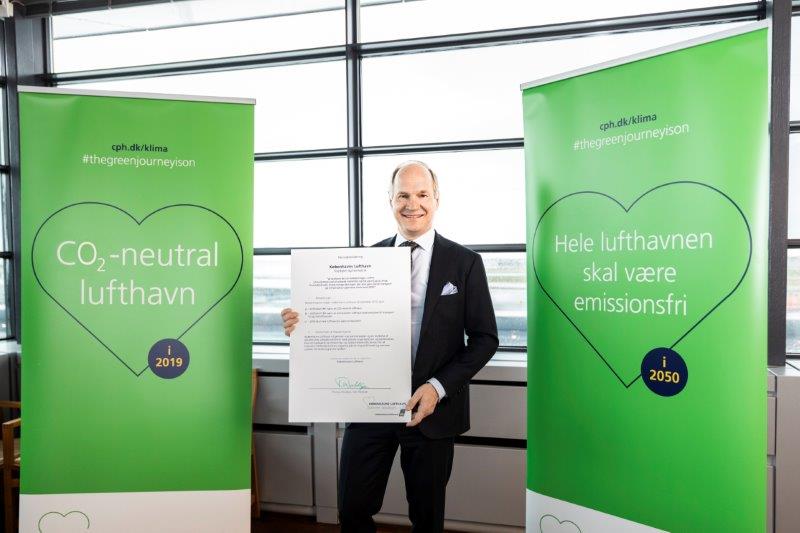New climate strategy: Copenhagen Airport to be CO2 neutral this year
Copenhagen Airport is launching a new climate strategy. In addition to setting ambitious goals for the airport’s climate activities, it will ensure that the airport becomes CO2 neutral as early as this year.

Today, CPH is launching its new climate strategy, which will generate real, future-proof solutions to the climate challenges faced by the aviation industry.
The goals of the strategy are:
- CPH will be a CO2-neutral airport in 2019. This will be realised by means of continued efforts to reduce the emissions over which CPH has control (in other words, energy and fuel consumption and staff business trips) and the implementation of climate compensation to neutralise CPH’s remaining emissions by supporting projects, both in Denmark and other countries, which reduce CO2.
- By 2030, CPH will be an emission-free airport with emission-free transport to and from the airport. This will be realised partly by CPH’s continued investment in solar panel systems and support of green conversion of land transport by improving the charging infrastructure for electric vehicles both within and outside the airport area.
- The entire airport will be emission-free by 2050. CPH will be entirely free of CO2 emissions from the airport itself, air traffic, companies operating in the airport and land traffic to and from the airport. This will be realised by means of strategic partnerships across the aviation industry, decision-makers and researchers, aiming at greater availability of sustainable fuel and the development of climate-friendly technologies.
“Each year, more than 30 million people travel via Copenhagen Airport on their way to discover the world and to return home with inspiration and experiences. The ability to fly all over the world is crucial for our prosperity and well-being - but this must not be at the expense of our climate. That is what inspired our new climate initiative. We are a vital part of Denmark’s infrastructure, and we regard it as our duty to come up with tangible, realistic solutions aimed at making Danish transport and infrastructure greener and, ultimately, emission free. In recent years we have significantly reduced our CO2 emission per passenger, but we have loftier ambitions. That is why I am delighted that not only are we setting goals for the future, but also that even this year we will become a CO2-neutral airport,” says Thomas Woldbye, CEO of Copenhagen Airport.
En route to the sustainable energy adventure
The climate strategy is a major element in the airport’s work as a responsible company. The goals will be realised partly by means of initiatives that will guide the airport in an even greener and more energy-efficient direction.
That means, for example, that the airport will produce much more of its own green power. We will also work to create smarter, greener, cleaner traffic on the ground, so that the airport’s staff can do their jobs with equipment and vehicles that do not use traditional fossil fuel. Additionally, both staff and passengers will be able to arrive at and leave the airport in sustainable modes of transport.
CPH has direct control over approximately 7% of the overall CO2 emissions from the airport, whilst flights, transport to and from the airport and consumption by other partners in and around the airport make up 93% of the overall emissions. Consequently, an important element of the airport’s climate strategy involves establishing partnerships that will contribute to research and development by devising solutions such as sustainable fuel, electric planes and other technologies to improve the climate.
“Sustainable fuel is the key to sustainable flight operations. The development of new, innovative solutions will require a focused, cost-intensive effort on the part of the entire aviation industry. That is why we also need politicians, educational and research institutions and experts to join us in our endeavours. The development of tomorrow’s jet fuel is also a potential Danish energy adventure which we at CPH wish to be part of. Our climate strategy obliges us to commit to a number of highly ambitious goals, and we are excited about further expediting the work in cooperation with the rest of the aviation industry,” concludes Thomas Woldbye.
Facts
- Copenhagen Airport is the biggest airport in Denmark. In 2018, 30.3 million people passed through the airport, taking advantage of one of the 183 different routes that depart from CPH. That amounts to 83,000 passengers a day – throughout the year.
- In 2018, CPH used 89 GWh of energy. That is the equivalent of 28,970 tonnes of CO2 or 0.96 kg of CO2 per passenger. In 1990 the figure was 3.6 kg of CO2 per passenger and in 2013 it was 1.3 kg.
- Between 2013 and 2018, CPH implemented total energy savings of 30.8 GWh: for example, by changing to LED lighting, replacing heating and ventilation systems and, not least, establishing our groundwater cooling system. That means that, despite a 6-million increase in the number of passengers, CPH has reduced its 2013 energy consumption by 35%.
- For more information, visit cph.dk/klima